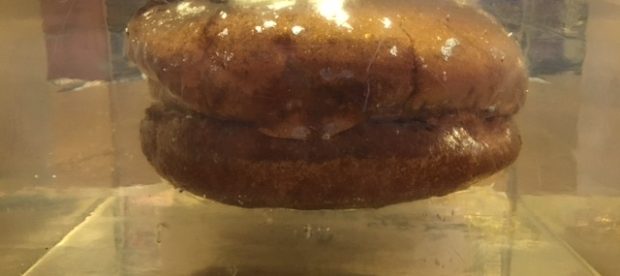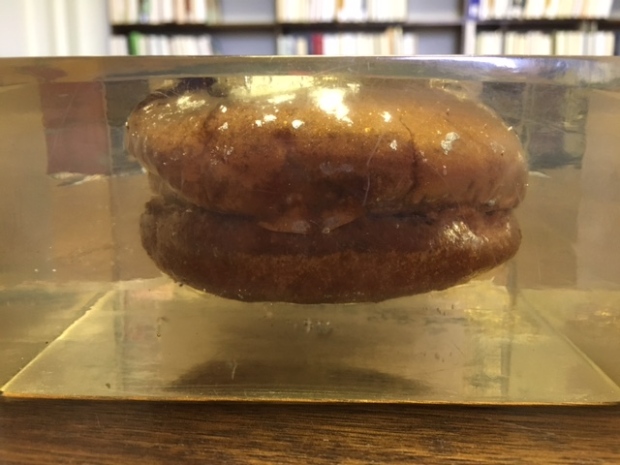The Hamburger on Display in a Canadian Legislature


That’s a hamburger.
No need to take my word for it, though. You can see it yourself. All you need to do is go to the Edmonton, the provincial capital of Alberta, Canada. Once there, ask for directions to what locals call “The Ledge,” but is more formally known as the Alberta Legislature Building. It’s where the legislature and executive branches of the provincial government meet. And it’s also where the burger lives, on display, for all to see.
It has to be there — because it’s an official government document.
Now, let’s be real here: the item above isn’t a “document” in the traditional sense — there are no words on it (unless the sesame seeds coincidentally spell something). It’s a burger, on a bun, with cheese, onions, and relish. And yet, that’s not how Alberta sees it.
The burger dates back to 1969. The legislature was debating something — it doesn’t really matter much, but it involved the word “supply.” A member of the assembly named Clarence Copithorne saw an opportunity. He wasn’t happy with the quality of the building cafeteria’s food options and wanted to make that point in an official capacity. Copithorne, per CBC Radio, took the floor and said: “When talking about supply, one thing they should supply us with right upstairs is good nourishment at noon.” And then, he offered some proof. He took a hamburger out of his desk — one he acquired from the cafeteria shortly before and the one seen above — and held it for all to see. According to a contemporaneous news report at the time (via Edmonton Journal), he thought that the burger spoke for itself, stating that “the honorable ministers can ask themselves why they can’t do something about this.” And with that, Copithorne handed the burger to the clerk of the assembly, perhaps so his colleagues could judge the paltry lunch offering for themselves.
Copithorne’s ploy worked — the other members of the assembly applauded in agreement and, ultimately, the menus improved. But the burger remained — just not in the cafeteria. It moved to the library. Valerie Footz, the legislature’s librarian, told CBC Radio that “anything that members table in the house becomes part of the official record.” Copthorne, by introducing the burger the way he did, entered it into the record — and therefore, had to be added to the library’s collection. Or, at least, that was the joke. The clerk sealed the burger in Lucite and, tongue firmly planted in cheek, gave it back to Copthorne as a keepsake.
Copithorne took the burger home and thereafter, it fell out of Alberta’s collective memory — until after he passed away. In 2008, his son found it while cleaning the garage of his now-deceased father, but instead of throwing it out, the younger Copithorne probably took note of its legislative significance. (He had a big clue: if you look at the other side of the burger, there’s a sign, also encased, which notes that the hamburger was “certified as an official document.”) So, he did the right thing: he son offered the relic to the legislative library.
The librarian accepted the burger, seeing it, again, as an official document. It’s been on display since.
Bonus fact: If you don’t like rats, you might really like Alberta — it’s a rat-free zone. Most species of rats can’t survive in Alberta’s climate and the one that can — the brown rat — isn’t native to the area and struggles to cross the province’s natural boundaries (such as the Rocky Mountains on Alberta’s western border). In the early 1950s, per Wikipedia, the province began aggressive measures to kill its rat population; these measures were successful and the rat population was eradicated. Today, as Wikipedia notes, the small number of rats that make it into the province are killed before they can reproduce, and if you import one yourself, watch out — having a pet rat is a crime “punishable by a penalty of up to $5,000 or up to 60 days in jail.”
From the Archives: Soup of the Day: Why bean soup is always on the menu at the U.S. Congress.
Related: Clear polyester casting resin, for all your hamburger encasing needs. Caution: don’t eat the burger afterward.
